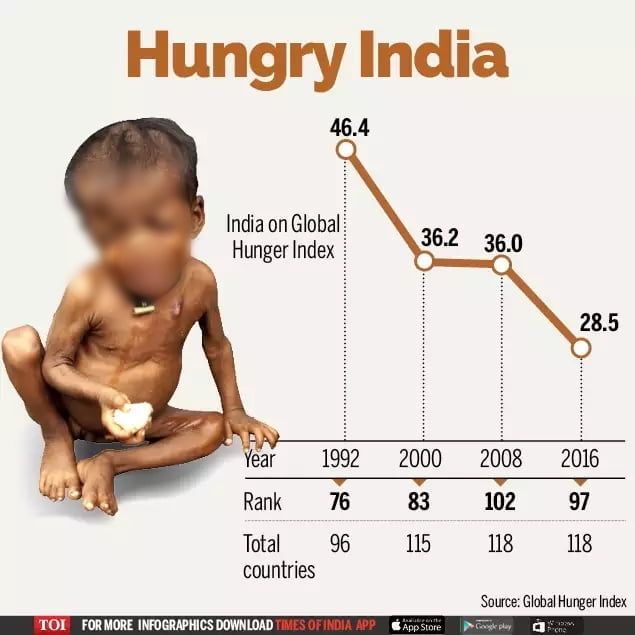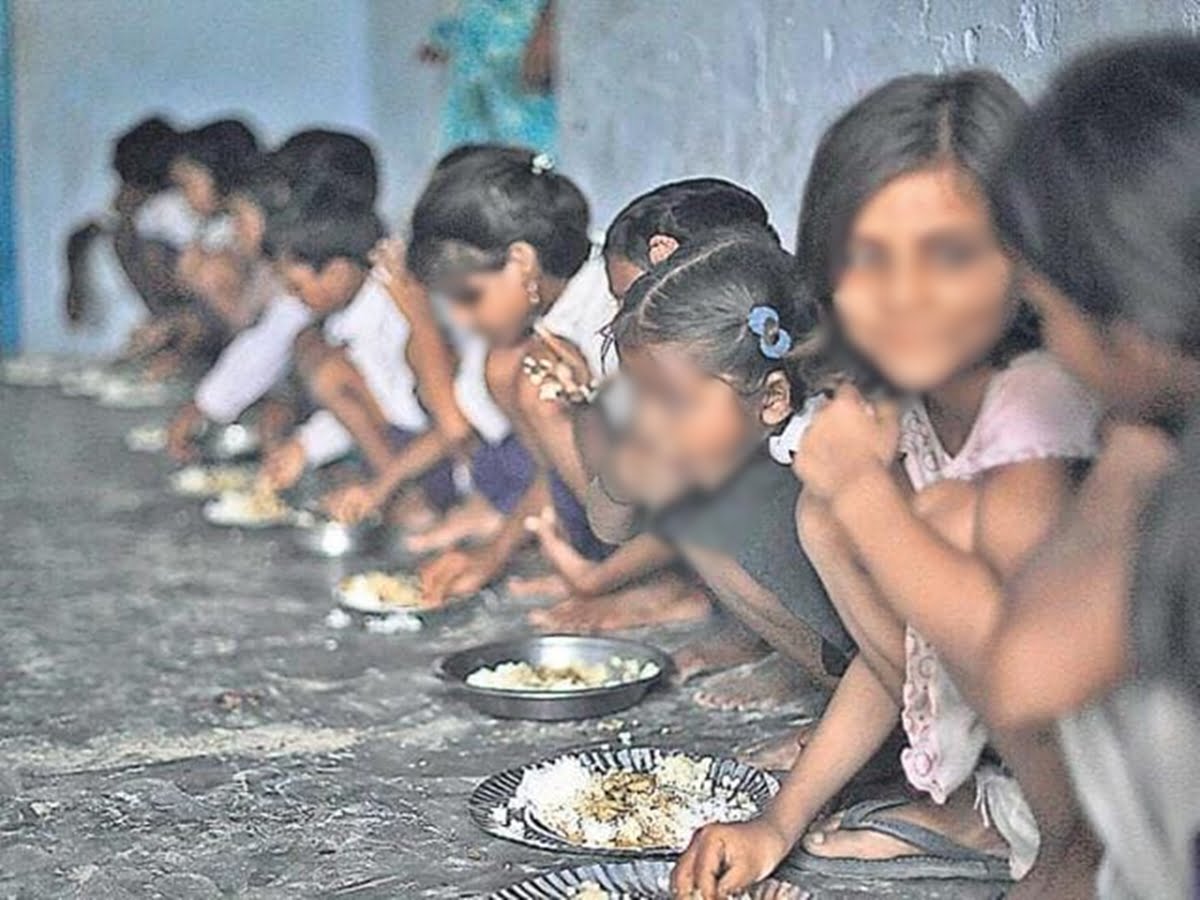The Global Hunger Index (GHI) 2021 ranked India at 101 out of 116 countries. This was an evident fall from its last year’s position of 94. While this report raises serious health concerns and suggests the immediate need to take measures about the devastating hunger situation in India, the government decided to respond to the report by criticising it instead of addressing the starvation issues in India.
Commenting on the worldwide followed methodology of the peer-reviewed report jointly published by Concern Worldwide and Welthungerhilfe, the Ministry of Women and Child Development said that the report is based on FAO estimate on the proportion of the undernourished population which is found to be “devoid of ground reality and facts and suffers from serious methodological issues”.
Commenting on the worldwide followed methodology of the peer-reviewed report jointly published by Concern Worldwide and Welthungerhilfe, the Ministry of Women and Child Development said that the report is based on FAO estimate on the proportion of the undernourished population which is found to be “devoid of ground reality and facts and suffers from serious methodological issues”.
Furthermore, the government added that “The report completely disregards government’s massive effort to ensure food security of the entire population during the Covid period, verifiable data on which are available. The opinion poll does not have a single question on whether the respondent received any food support from the government or other sources.”
Though the Indian government has not released any figures relating to the starvation rate in India during Covid-19, they have quite easily disregarded any hunger related reports. Further, it is important to be noted how hunger related deaths are recorded as deaths due to cholera or dysentery to avoid scrutiny.
Also read: FII Interviews: Dr Reetika Khera, Development Economist & Professor

This is not the first time the government has responded bizarrely to efforts to highlighting India’s hunger condition. Two years ago, a journalist named Pawan Kumar Jaiswal from Mirzapur district of Uttar Pradesh did a story on how as part of the mid-day meals scheme in government schools in UP, students were being served just salt and roti. As a result, he along with the village head representative were arrested on the alleged case of defamation of state authorities.
Ideally, the government’s Mid Day meal scheme prescribes that children in government-aided primary schools be served pulses, rice, rotis and vegetables to provide a minimum of 450 calories per child each day. In the video recorded by the journalist, the students of the Siyur Primary School in Jamalpur block of Mirzapur district were being served only salt and roti in their midday meal.
Unable to explain the reason for the arrest and alleged conspiracy for defaming the government, Mirzapur’s district magistrate Anurag Patel said in an interview that “You are a print media journalist, you could have taken photos. You could have printed it, but you did not do it. We found his role in the matter to be suspicious”.
Even as the government seems to be in denial of every starvation-related story, the ground reality is completely different. There are a lot of cases of hunger-related deaths in India, which is so disheartening. Reportedly, three lakh children die of starvation every year in India.
In 2018, the case of three girls dying from starvation in Delhi made headlines. A man from West Bengal moved to Delhi in search of a better life but to his distress, his life got worse when his rented cycle-rickshaw got stolen twice in a week. He was a rickshaw-puller from East Delhi’s Mandawali area and it was his only source of income to feed his family of three children and a wife. This incident affected his wife’s mental health and he resorted to alcohol dependency which impacted their ability to provide food to their three girls aged eight, four, and two. This led to the the deaths of the girls due to starvation.
Though the family was living in Delhi for over a decade, they did not have a ration card that would have helped them avail food grains at lower prices. The 2013 National Food Security Act ensures legal entitlement of five kilos of foodgrains at INR 2-3 per kilo for over two-third of India’s population and foodgrains are available at the nearest grocery store.
Also read: Farm To Table: Food Must Be Sustainable From Production To Consumption
Furthermore, under the Integrated Child Development Scheme, children up to six years of age are entitled to supplementary nutritional support in the form of dry rations and hot cooked meals at Anganwadi centres. But the loopholes in the food distribution system like refusing or withholding food grains and other basics due to document issues leads to cases like these where people starve to death.
The cases of starvation existed even before the pandemic and the increase in these cases during Covid-19 do not come as a shock, given the increased rate of unemployment, dire living conditions, fragile healthcare and unavailability of food that we have witnessed.
Last year, a five-year-old girl named Sonia Kumari starved to death in Nagla Vidhichand village in the state of Uttar Pradesh. “For eight days, there was not a single grain in our house to eat and my sister became very weak during this time”, mentioned Sonia’s sister.
Sonia’s mother reportedly worked at a construction site and is the sole earner of the family. After the sudden lockdown announced in March 2020 by Prime Minister Narendra Modi, a lot of people including Sonia’s mother found themselves without the jobs.
Approximately 90 per cent of India’s 425 million strong workforce is employed in informal sector and rely on daily-wages. Due to the lockdown, they lost their jobs and were left without any income.
Not just Sonia’s mother, but no one in the village had a ration card as they couldn’t afford to apply online and they didn’t receive any response from the local officials when they were visited in-person. There are many more cases like this one. In the state of Jharkhand, over 700,000 ration card applications were reported to be pending as of 2020.
There are various government schemes catering to the supply of food, but the food is not reaching the poor due to disruption in food distribution systems. For instance, in 2018-2019, only 14 states in India utilised the funds entirely dedicated to the Mid Day Scheme for children.
The population of the low-income class in India was noticeably high even before the pandemic and number of poor people with income less than $2 have been estimated to have increased by 75 million due to Covid-19 as per a report by Pew research.
One of the reasons for decrease in income is loss of employment and the low-income could possibly be linked to the inability of people to buy food. Hence, the undernutrition crisis in India. It is therefore important that the government focus on strictly monitoring policies related to heath, employment, housing and sanitation.
One of the reasons for decrease in income is loss of employment and the low-income could possibly be linked to the inability of people to buy food. Hence, the undernutrition crisis in India. It is therefore important that the government focus on strictly monitoring policies related to heath, employment, housing and sanitation.
The government should step up instead of debating the veracity of the report and make it a political agenda. Rather, it is important to take actions to ensure that no one has to go to sleep hungry. Food is a basic human necessity and the unavailability of food to a level that can cause death is not only a disgrace to a country but is disheartening.
About the author(s)
Pragati Parihar is a masters student, studying International Relations at University College Dublin, Ireland, and is highly interested in topics such as feminism, gender based violence, and gender representation in politics. Also a travel enthusiast and an avid reader of mythology!




